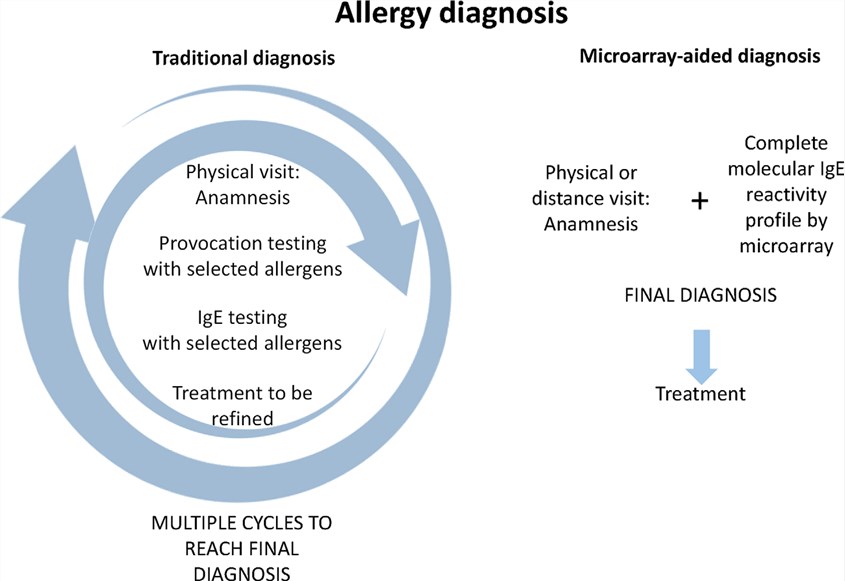Antigen Microarray Detection Service for Autoimmunity, Allergy, and Infection
The antigen microarray detection platform developed by Creative Biolabs provides customers with professional services for autoimmunity, allergy, and infection studies, and you can get customized services, professional guidance and satisfactory project results here.
Background
Overview of Autoantibodies in Autoimmunity, Allergies, and Infections
Autoantibodies play an important role in autoimmunity, allergies, and infections. Autoantibodies target self-antigens in autoimmunity, leading to immune system attacks on the body's tissues. In allergies, they react to harmless environmental antigens, triggering allergic reactions. During infections, autoantibodies may cross-react with microbial antigens, influencing the immune response and potentially impacting disease outcomes.
Antigen Microarray Detection for Autoimmunity
Autoimmune diseases are characterized by the dysregulated activity of the immune system against self-antigens, resulting in chronic inflammation, tissue damage, and disability. The analysis of the antibody repertoire with antigen microarrays led to large-scale analyses of the immune response in autoimmune diseases, allergies, response to tumors, vaccinations, and infections. Antigen microarrays provide a unique tool to interrogate the immune response in autoimmune disorders, with important potential applications for disease management. These applications include disease diagnosis, for the early diagnosis of individuals developing autoimmune disorders before the onset of symptoms and also for the identification of individuals at risk of developing a specific autoimmune disease; disease monitoring, to stage patients and monitor disease progression and response to therapy; and discovery of mechanisms of pathogenesis, leading to the identification of targets for therapeutic intervention.
 Fig.1 Antigen microarrays for the study of autoimmune diseases.1
Fig.1 Antigen microarrays for the study of autoimmune diseases.1
Antigen microarrays also provide a new tool for the investigation of the immune response in autoimmune disorders and other conditions such as allergies. Once current technical limitations are overcome, antigen microarrays have the potential to revolutionize the diagnosis, monitoring, and therapy of autoimmune diseases.
Application
Antigen Microarray Detection for Allergy
The most widely used and best-characterized multiplex IgE assay is the Immuno Solid-Phase Allergen Chip (ISAC). The current assay uses 112 allergen components representing more than 50 allergen sources. IgE microarray and other multiplex assays are emerging and offer some important advantages over traditional singleplex assays. In the short term, the major use of these assays likely resides in research studies, particularly for microarrays in cohort studies in which large amounts of information can be gleaned from a limited biological sample. It will not be surprising to see further debates over the relative merits of currently available in vitro multiplex diagnostics, including the number of sensitizations that should be measured concurrently.
 Fig.2 Comparison of traditional allergy diagnosis and microarray-aided allergy diagnosis.2
Fig.2 Comparison of traditional allergy diagnosis and microarray-aided allergy diagnosis.2
Antigen Microarray Detection for Infection
- Bacterial Infection
Previous reports have constructed a peptide microarray with 61 Mycobacterium tuberculosis presented as linear 15 aa peptides with a 3 aa shift yielding 7446 individual peptide epitopes. This study clearly underlines the potential of antigen microarrays not only for identifying reactivity patterns of antibodies, but also to derive information about meaningful targets in bacterial infection for vaccine development. In a related approach, peptide microarrays were also used to select diagnostic antigens of microbial infection by Echinococcus spp. with a chip presenting 45 peptides. Peptide microarrays have proven successful in screening whole cells against ligands immobilized on the chip and for the discovery of antibacterial peptides.
- Viral Infection
During viral infection, nucleic acids of the pathogen normally can be detected earlier than antibodies. This makes detection by PCR which is the method of choice for most viral infections. However, for some viruses, especially those that give rise to only transient infections with either low or intermittent virus load, serology can still be more sensitive. Epitope patterns revealed by different patient subsets could potentially be informative in predicting the patient’s prognosis or in gaining insight into the immune systems' battle against the infection. Antigen microarrays were first developed to profile the breadth, strength, and kinetics of epitope-specific antiviral antibody responses in vaccine trials with a simian-human immunodeficiency virus (SHIV). Researchers surveyed the evolution of anti-SHIV immune response and observed a strong convergence of antiviral B-cell specificities with a restricted set of linear epitopes in the presence of the immunogen, while vaccine-induced anti-SHIV responses against a spectrum of non-immunodominant epitopes were lost after challenge. The array profiles rather than single antibody reactivities thereby allowed distinguishing vaccinated from challenged animals, and the breadth and persistence of antiviral antibody responses served as a predictor of mortality.
Our Service
Services at Creative Biolabs
As the researchers gradually study autoantibody deeper, the important role it plays in autoimmunity, allergy, and infection has been revealed step by step. In this context, antigen microarray detection attracted a lot of sight from researchers working on autoimmunity, allergy, and infection for its high throughput and accuracy. Studying autoantibodies over years, Creative Biolabs has thrown a great deal of manpower, materials, and financial resources. During this period, we have accumulated extensive experience from practice and established our technology platform offering customers-satisfied Antigen Microarray Detection services for Autoimmunity, Allergy, and Infection to global clients.
Highlight
- High-throughput, multiplexed detection
- High sensitivity, specificity, and customization
- Small sample volumes
- Automated and efficient data analysis
- More standardized and user friendly experimental procedures
FAQs
-
Q1: How do you perform data analysis?
A: We have experienced data analysis experts and use advanced bioinformatics tools and statistical methods to help process and interpret complex data sets, helping you achieve your ideal research goals. -
Q2: How to inquire about detection plan?
A: You can contact us directly and we will have experts discuss detailed plans with you. If you have any questions during the process or about the results, we will also communicate with you at any time.
Resource
If you are interested in our antigen microarray detection services or you have any other questions about autoantibodies, please don't hesitate to contact us for more information.
Reference
- Zhu, Honglin, et al. "Autoantigen microarray for high-throughput autoantibody profiling in systemic lupus erythematosus." Genomics, proteomics & bioinformatics 13.4 (2015): 210-218.
- Huang, Huey-Jy, et al. "Microarray-based allergy diagnosis: quo vadis?" Frontiers in Immunology 11 (2021): 594978.
Related Services:
- Autoantigens General Survey Detection
- Brain and Central Nervous System Disorders Detection
- Cancer and Neoplasms Detection
- Common Allergens Detection
- Coronavirus-Associated Autoimmunity Detection
- SARS-CoV-2 Coronavirus Detection

